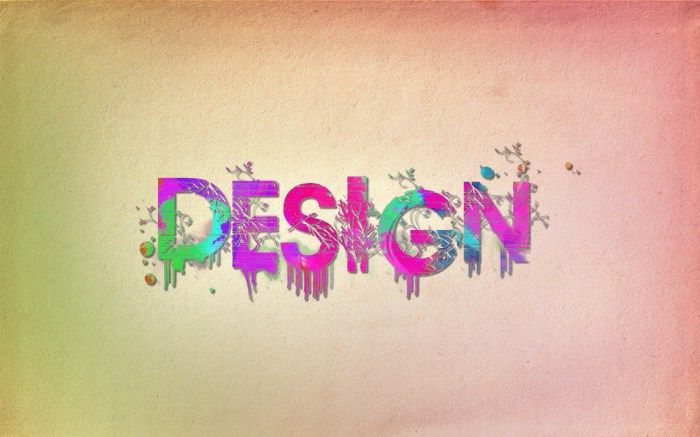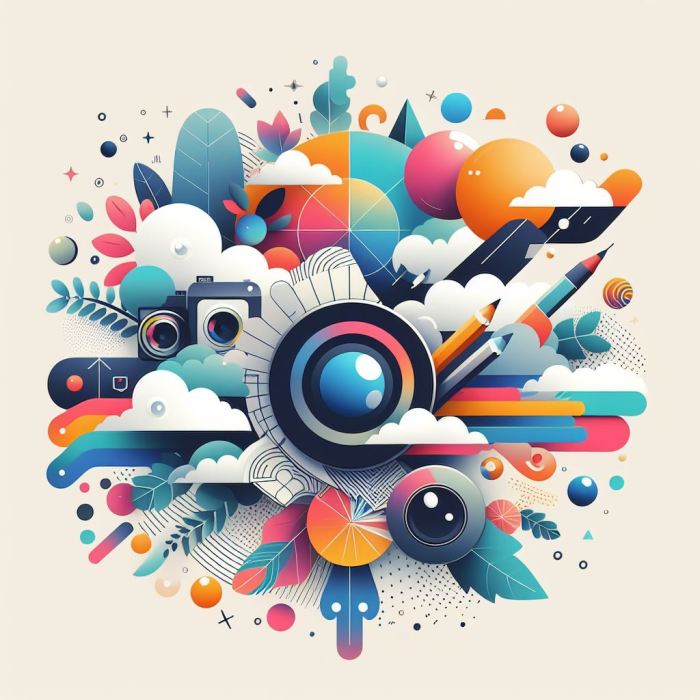Crafting Compelling Design: A Journey into the World of Creativity
Design sets the stage for this enthralling narrative, offering readers a glimpse into a story that is rich in detail and brimming with originality. From the importance of design in various industries to the latest trends shaping modern aesthetics, this exploration delves deep into the art and science of design.
As we unravel the fundamental elements, diverse types, intricate processes, and emerging trends in design, prepare to be captivated by the transformative power of creativity and innovation.
Importance of Design
Design plays a crucial role in various industries, influencing not only the aesthetics of products but also their functionality and user experience. From fashion to technology, design impacts how we interact with and perceive a wide range of products and services.
Impact on User Experience
Design directly affects user experience by determining how intuitive and enjoyable a product is to use. Well-designed products are more user-friendly, leading to higher customer satisfaction and loyalty. For example, Apple's iPhone revolutionized the smartphone industry with its sleek design and user-friendly interface, setting a new standard for usability and aesthetics.
Success of Well-Designed Products
Well-designed products often see greater success in the market due to their ability to attract and retain customers. Companies like Tesla have gained a competitive edge by prioritizing design in their electric vehicles, appealing to consumers who value both sustainability and style.
The success of these products demonstrates the significant impact that design can have on a company's bottom line and overall reputation.
Elements of Design

When it comes to design, there are several fundamental elements that play a crucial role in creating visually appealing and effective designs. These elements include color, typography, and layout, each contributing to the overall aesthetic and functionality of the design.
Color
Color is a powerful tool in design, evoking emotions, setting the mood, and creating visual interest. Different colors can convey different messages and meanings, so it's essential to choose a color palette that aligns with the purpose and target audience of the design.
Typography
Typography refers to the style, size, and arrangement of text in a design. It helps establish hierarchy, readability, and visual appeal. Choosing the right fonts and text styles can significantly impact how the message is perceived by the audience.
Layout
Layout involves the arrangement of elements within a design, including images, text, and white space. A well-thought-out layout can guide the viewer's eye, create visual balance, and enhance overall readability and usability.The principles of design, such as balance, contrast, and emphasis, are essential guidelines that designers follow to create harmonious and visually appealing designs.
Balance ensures that elements are evenly distributed throughout the design, creating stability and visual equilibrium. Contrast helps create visual interest by highlighting differences in color, size, or shape. Emphasis allows designers to draw attention to specific elements, guiding the viewer's focus and creating hierarchy within the design.Incorporating visual hierarchy is crucial for enhancing design clarity and ensuring that the most important information stands out.
By using different text sizes, colors, and placement, designers can effectively communicate the message hierarchy and guide the viewer through the design in a logical and intuitive way. This helps improve readability and overall user experience, making the design more impactful and engaging.
Types of Design
Design encompasses various disciplines that cater to different needs and purposes. Let's delve into some of the key types of design and highlight their unique characteristics.
Graphic Design
Graphic design focuses on visual communication and the arrangement of images and text to convey a message effectively. Designers in this field use tools like Adobe Photoshop and Illustrator to create logos, posters, and other visual materials.
Web Design
Web design involves creating the layout, structure, and aesthetics of websites. It requires knowledge of coding languages like HTML, CSS, and JavaScript to bring designs to life on the web. User experience (UX) and user interface (UI) play a crucial role in web design to ensure seamless navigation and interaction for users.
Interior Design
Interior design revolves around enhancing the interior spaces of homes, offices, and commercial establishments. Designers focus on optimizing functionality, aesthetics, and comfort to create harmonious environments that cater to the needs and preferences of the occupants.
Digital Design vs. Print Design
Digital design involves creating visuals for digital platforms such as websites, mobile apps, and social media. It allows for dynamic and interactive elements like animations and videos. On the other hand, print design is tailored for physical mediums like brochures, magazines, and packaging.
Each type of design requires different considerations in terms of layout, color, and resolution to cater to its respective medium.
Role of UI/UX Design
User interface (UI) design focuses on the visual and interactive elements of a product, ensuring a seamless and intuitive user experience. User experience (UX) design, on the other hand, emphasizes the overall feel of the product and how users interact with it.
Both UI and UX design are crucial in creating products that are user-friendly, engaging, and effective in meeting user needs.
Design Process
The design process is a systematic approach used by designers to create solutions to problems or challenges. It typically involves various stages such as research, ideation, prototyping, and testing. Each stage plays a crucial role in ensuring that the final design meets the desired objectives and requirements.
Research
Research is the initial phase of the design process where designers gather information and insights related to the problem they are trying to solve. This stage helps in understanding the target audience, market trends, and existing solutions. Research lays the foundation for the rest of the design process by providing valuable data to inform the design decisions.
Ideation
Ideation involves generating a wide range of ideas and concepts based on the research findings. Designers brainstorm, sketch, and explore different possibilities to address the problem creatively. This stage encourages innovation and out-of-the-box thinking, leading to unique and effective design solutions.
Prototyping
Prototyping is the phase where designers create tangible representations of their ideas to test and evaluate them. Prototypes can range from rough sketches to interactive models, depending on the complexity of the design. This stage allows designers to visualize the concept in a practical context and identify any potential issues or improvements.
Testing
Testing is the final stage of the design process, where prototypes are evaluated by users to gather feedback. Designers observe how users interact with the design, gather insights, and make necessary adjustments to improve the user experience. Testing ensures that the final design meets the needs of the users and achieves the desired outcomes.
Design thinking fosters innovation and problem-solving by emphasizing empathy, creativity, and collaboration. It encourages designers to approach challenges from a user-centered perspective, leading to solutions that are user-friendly and impactful.
Iteration and feedback are essential in refining designs as they allow designers to make incremental improvements based on user input and testing results. By iterating on designs and incorporating feedback, designers can create more effective and successful solutions.
Trends in Design

Design trends are constantly evolving, influenced by various factors such as technological advancements, cultural shifts, and environmental awareness. Keeping up with these trends is crucial for designers to stay relevant and innovative in their work. Let's explore some of the current trends shaping the design landscape today.
Minimalist Design
Minimalist design continues to be a popular trend across various design fields, characterized by simplicity, clean lines, and a focus on essential elements. This design approach emphasizes clarity and functionality, creating elegant and timeless designs that are visually appealing.
Dark Mode
Dark mode design has gained popularity in recent years, offering a sleek and modern aesthetic while also providing benefits such as reduced eye strain and improved battery life for digital devices. Many applications and websites now offer a dark mode option to enhance user experience.
Neumorphism
Neumorphism is a design trend that combines elements of skeuomorphism and flat design, creating interfaces that mimic real-world objects with subtle 3D effects. This trend adds depth and realism to digital designs, making user interfaces more interactive and engaging.
Technological Advancements Impact
Technological advancements such as augmented reality, artificial intelligence, and virtual reality are revolutionizing design practices. These technologies enable designers to create immersive and interactive experiences, pushing the boundaries of traditional design approaches.
Sustainability and Eco-Friendly Design
As environmental concerns become more prominent, sustainability and eco-friendly design practices are influencing modern design trends. Designers are incorporating recycled materials, energy-efficient solutions, and biophilic design principles to create eco-conscious designs that minimize environmental impact.
End of Discussion
In conclusion, design is not just about aesthetics; it's a powerful tool that shapes our experiences and influences our perceptions. As we navigate through the ever-evolving landscape of design, let's embrace the endless possibilities it offers to create meaningful connections and impactful solutions.
Q&A
What is the role of user interface (UI) design in the design process?
UI design focuses on creating visually appealing interfaces that enhance user interaction and experience.
How do design principles like balance and contrast affect the overall outcome?
Balance and contrast contribute to the visual appeal and readability of a design, creating a harmonious and engaging composition.
What are some current design trends shaping the industry?
Some of the latest design trends include minimalist design, dark mode interfaces, and the rise of neumorphism.




